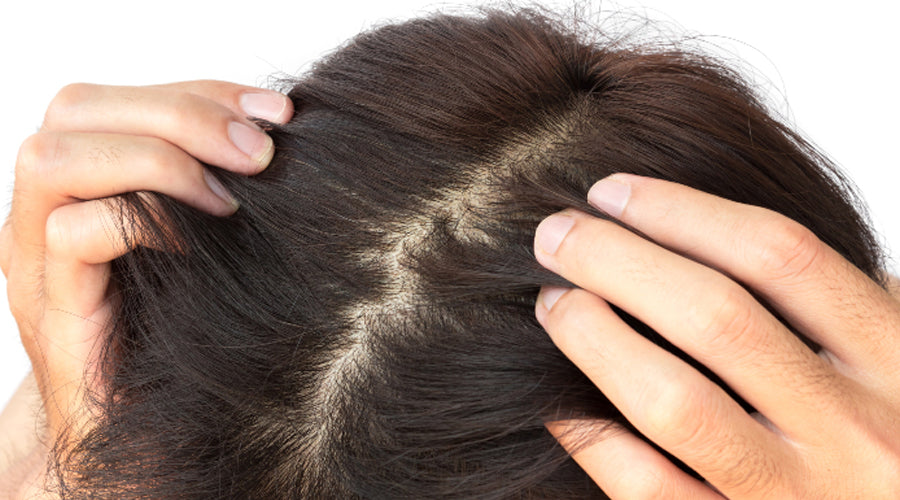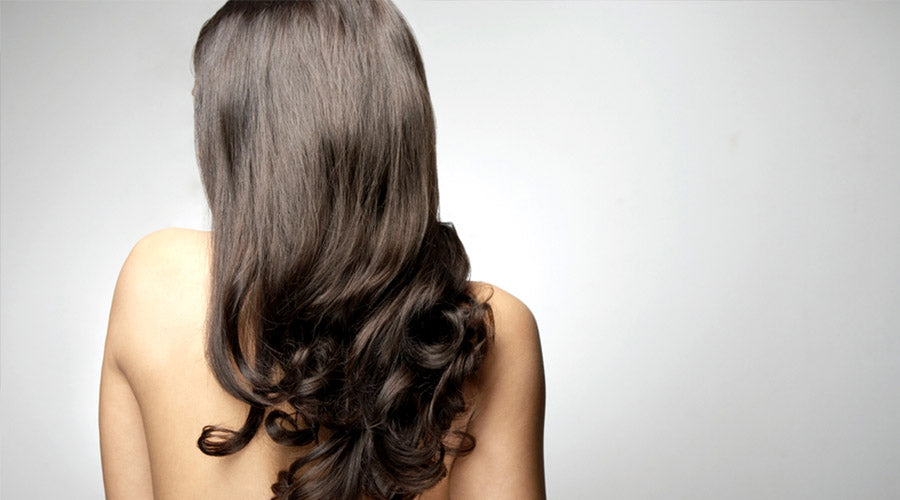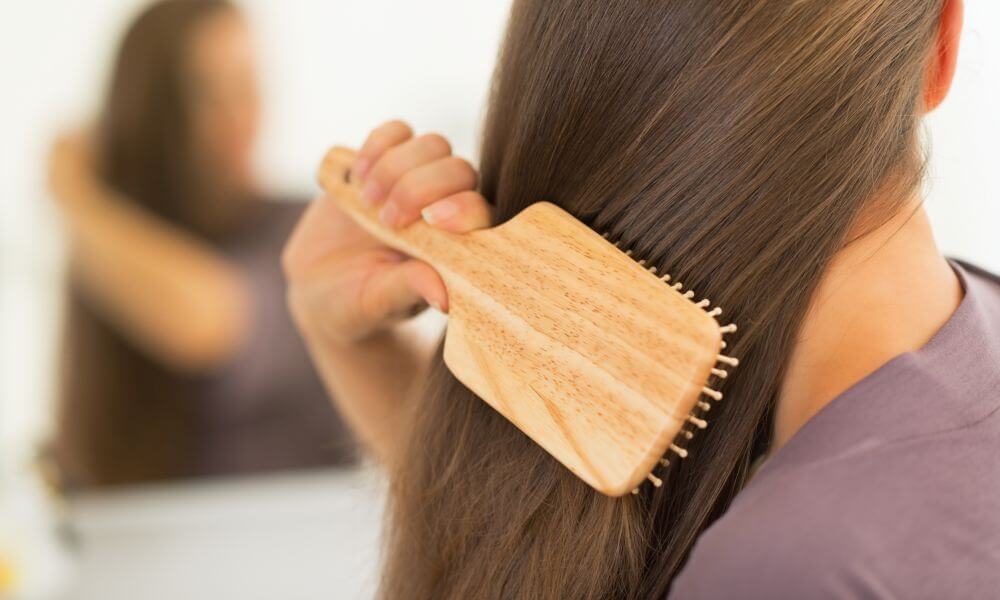Learn how to make your hair grow faster and finally get those beautiful locks you've always wanted
Table of contents:
What makes your hair grow?
How fast does hair grow?
What helps hair grow?
How to grow long hair.
There’s a reason hair extensions are all the rage these days: Vast numbers of people crave long, luscious hair, and they’re not always sure how to achieve it via natural growth. In fact, most people know very little about what makes hair grow in the first place—let alone whether there’s anything they can do to potentially grow hair faster.
So it’s high time we got the word out. Here’s a crash course in the basics of hair—from how hair grows (and how fast) to some proven strategies to employ in the quest for longer, more luscious locks.
How to Grow Hair

According to the American Academy of Dermatology (AAD), hair grows naturally out of the follicles in your skin and scalp. Here’s a basic overview of how hair grows from the scalp:
- First, your hair starts growing down at the bottom of follicles in the scalp. People typically have around 100,000 follicles on their head. Hairs grow from roots at the bottom of these follicles; the roots are composed of protein and cells.
- The hairs’ roots are nourished by blood from the blood vessels in your scalp. This “food” provides the energy for making more cells and stimulating hair growth.
- As a hair grows, it eventually passes by an oil gland and then gets pushed out through the skin by new hair growth behind it. At the point that hair emerges through skin, it’s dead—which is why it isn’t painful to brush or cut your hair. Making contact with the oil gland explains why hair tends to be shiny and/or soft. (It also explains why hair gets greasy and needs to be washed.)
Just as you grow hair every day, you’re also losing hairs every day. The AAD says that you lose approximately 50 to 100 hairs per day, because sometimes scalp follicles take a break from growing hair. (Follicles typically take one of these rest breaks every few years.) Because some follicles are growing hair while others take breaks, it all evens out and you’re unlikely to notice normal levels of hair loss.
If you want to get a bit more technical, then you could say that hair goes through three distinct phases:
- Anagen. This is the most active stage of hair growth, and most follicles will remain in this stage for anywhere from two to six years. During this phase, cells in the hair’s root divide rapidly, which means they’re frequently forming new hairs. These new hairs push the dead hair above them up and out through the skin.
- Catagen. This transitional stage lasts for approximately two or three weeks. During this phase, growth stops and dead “club hairs” form. These club hairs will remain beneath the surface of the skin until they’re pushed out by new hair growth behind them.
- Telogen. This is the resting phase described above. During this phase, new hairs stop forming behind the club hair and these club hairs naturally shed off. When it comes to hairs on the scalp, this phase typically lasts for around 100 days before a follicle becomes active again.
Several factors—including hair type, genetics, health conditions, nutrition, stress, medications, hormonal changes, and age—may influence this process. As we age, for example, some follicles may stop working. This explains why many elderly people have thinner hair than they did when they were younger.
How Fast Does Hair Grow?

Image by Activilong
How fast hair grows differs slightly person to person, but the average is:
- Approximately 0.3 to 0.4 mm per day.
- Or, around ½ an inch per month or six inches per year.
That may not sound like a lot, but the AAD says that the hair on your head is one of the fastest growing parts of your body, second only to bone marrow.
While this is true for all genders, hair on men typically grows faster than hair on women—although pregnancy often proves an exception to this general rule. During pregnancy, levels of the hormone estrogen increase. This increases the number of follicles in the active growing phase, which can speed up hair growth.
As noted above, several other factors may influence the speed of hair growth. These include age, health conditions, medications, and so on. Even the seasons can influence how fast hair grows; most people will notice that their hair grows a bit faster in warmer months and slower in colder months.
How to Make Hair Grow Faster

As noted above, hair growth is a natural process that will occur without any outside help. But certain lifestyle and hair care choices may help speed up this process and/or keep hair healthier and stronger as it grows. For instance, there’s some evidence that the following factors may help promote strong, healthy hair and unimpeded hair growth:
- Gentle hair care products that help keep the scalp and hair healthy
- Hair care practices such as getting regular trims, avoiding daily shampoos, conditioning after every shampoo, avoiding harsh treatments, and brushing carefully
- Eating a healthy diet that’s rich in vitamins and minerals
- Utilizing friction-free bedding, e.g. silk pillowcases
In the following section, we’ll discuss how to apply these principles in order to grow longer, healthier hair as quickly as possible.
How to Grow Your Hair Faster

Because hair growth occurs naturally at the cellular level, there’s nothing any of us can do to force our hair to grow at a certain rate. But there are several steps you can take to make your hair as healthy and strong as possible so that it grows as fast as it can. Here are several proven strategies for growing long hair:
- Get regular trims. It may seem counterintuitive to cut your hair when you’re trying to grow it long. But regular trims can help keep the hair stronger and reduce the risk that you’ll need to cut off more of the hair in order to keep it healthy. That’s because you’ll be able to trim off split ends before they’ve worked their way up the strands, which would require a more dramatic chop in order to return hair to a healthy state.
- Choose the right products. Many hair care products contain harsh chemicals that can strip the hair and scalp of their natural oils and disrupt healthy pH levels. This can damage the scalp and hair and inhibit the growth of healthy hair. For this reason, it’s important to avoid harsh cleaning agents and opt instead for natural, organic, and gentle hair care products. (In particular, make sure to opt for sulfate-free products like ours.)
- Prioritize scalp health. Because hair growth occurs on the scalp and is fed by blood vessels in the scalp, it’s important to make sure hair has a healthy environment in which to grow. To that end, make sure to choose your hair care products carefully (as noted above) and aim to avoid over-washing (which can dry out the scalp). You might also consider exfoliating the scalp every week or so with a gentle product. And be sure to give your scalp a finger massage whenever you shampoo in order to promote healthy circulation.
- Avoid shampooing every day. As noted above, daily shampoos can dry out the scalp and make it a less hospitable environment for hair growth. What’s more, constant shampooing can strip the hair of its natural oils, which prevents these oils from hydrating and repairing the hairs. This can provoke hair damage, which may require a cut. If possible, stick to shampooing your hair only two or three times a week.
- Condition every time you shampoo. The right conditioner helps replace healthy fats and proteins in the hair shaft, which encourages hair repair and protects the hair from damage. As noted above, stronger hair is better equipped to grow long—so think of conditioner as your hair’s strength training routine, and don’t skimp. For extra credit, consider applying a weekly oil or mask conditioning treatment.
- Ease up on harsh treatments. Hot tools, chemical relaxers, and so on can all damage your hair. That damage might require cutting in order to bring the hair back to a healthy state, which can prolong the time that it takes for hair to grow long. To increase the odds of hair staying strong and healthy, limit the frequency with which you use heat or other harsh treatments.
- Brush carefully. When and how you brush your hair can have a big impact on your hair’s health. Brushing on a daily basis has several benefits: It promotes circulation on the scalp, removes hairs that have fallen out, and helps to distribute natural oils that protect the hair from damage (and give it a pleasant shine). To increase the odds of your hair remaining strong and luscious, choose a brush that has rounded prongs. Brush from the ends and gently work your way up instead of brushing from the roots downwards—this is especially important when your hair is wet.
- Eat well. A healthy diet increases the odds of having a healthy scalp and healthy hair, and it also provides the fuel necessary for hair growth. Research suggests it may be helpful to incorporate the following into your diet: biotin, iron, omega-3 and omega-6, vitamin C, vitamin D, and zinc. Natural sources of some of these nutrients include avocados, beans, berries, eggs, fish, nuts, olive oil, salmon, and sweet potatoes.
-
Invest in a silk pillowcase. Silk is smoother than cotton, which means it creates less friction when you lay your head (and your hair) down on the pillowcase. This means silk is less likely to break or tangle the hair, which can keep it healthier and won’t delay progress when it comes to growth.
Summary
Hair growth occurs naturally as a result of processes that take place in the follicles on your scalp. Several factors affect the rate at which this hair growth takes place, but most people can expect to grow their hair at a rate of approximately six inches per year (so long as their hair and scalp are healthy).
If you want to grow long hair, there are several strategies that can help you enjoy strong, luscious locks. Make sure to eat well, care for your scalp, be gentle on your hair, and opt for gentle hair care products such as our paraben-free, perfume-free, and sulfate-free shampoos and conditioners. These products are packed with plant-based and gentle ingredients that help maintain a healthy pH balance and leave you with stronger hair and a healthier scalp.
Together with a few proven lifestyle strategies, these products will help you on your way toward growing long, shiny hair.


